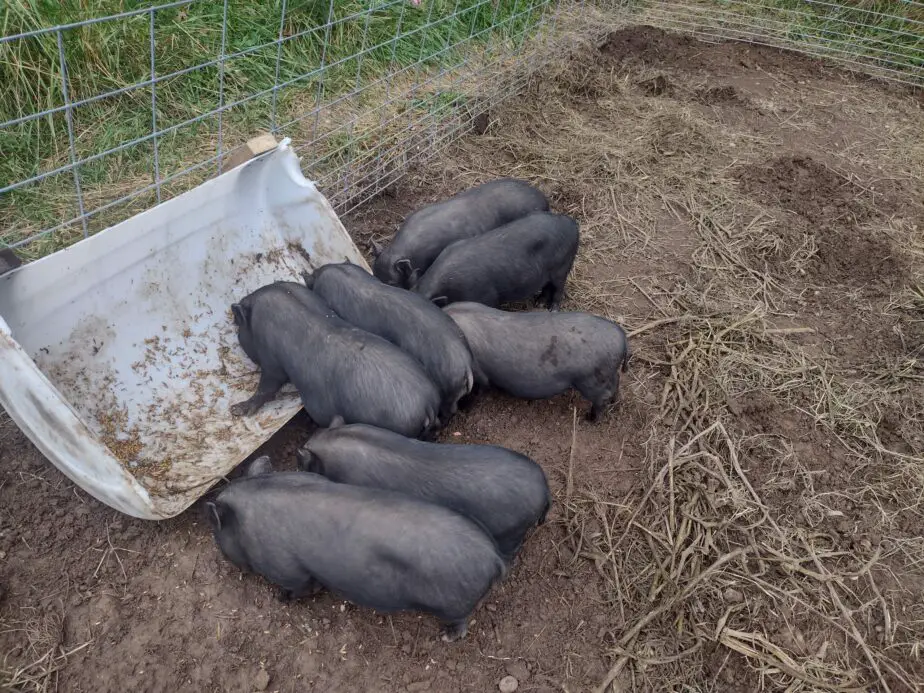We’ve raised pigs for years and have tried a lot of different feed options in that time.
The best feed for pigs is a fermented grain-based mix with added protein, green vegetation, and mineral and vitamin supplements. Fermenting feed improves pig wellness and growth. You can ferment regular hog feed, of ferment whole grains, and add other available ingredients to balance it.
What to feed pigs is a contentious point among farmers and many stick to tradition regardless of what science or local options should dictate.
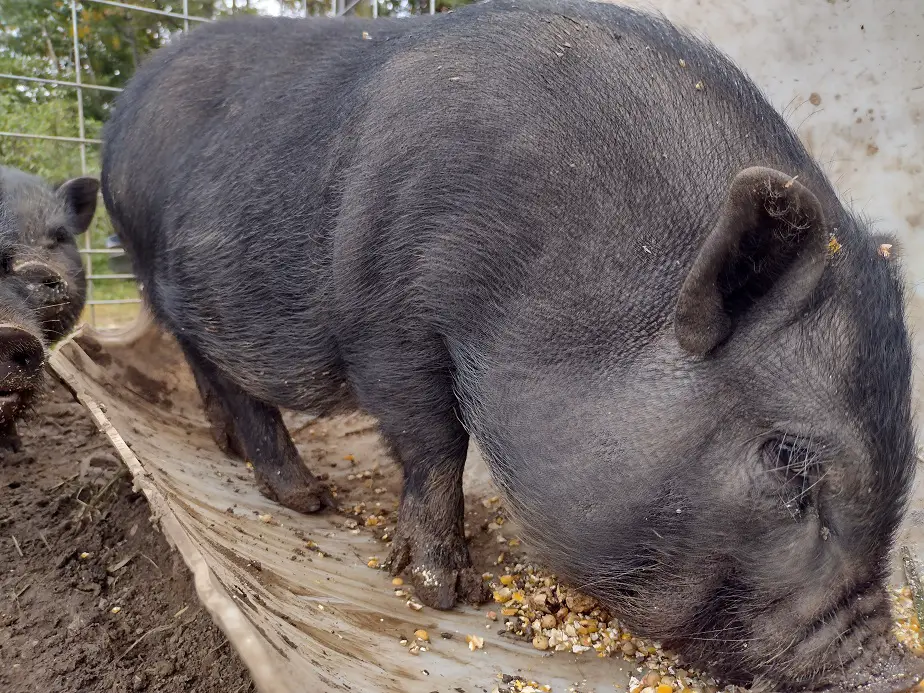
Feeding Pigs for the Best Meat Growth
If you want to maximize your meat production, a carbohydrate-rich, high-protein feed is needed. The largest growth-limiting dietary factors are low Lysine levels and poor gut health of an animal. Providing proper protein and introducing helpful bacteria are the best ways to keep a pig growing.
In the US, the Most common formulation for feed is about 80 percent ground corn and 10 percent soybean meal. The other 10 percent is a combination of minerals, vitamins, and added oil. It’s not a bad mix and pigs grow well on it. If you buy pelleted hog feed or hog mash (dry powder), that’s what it is.
Specialty feeds use other grains like wheat, oats, sorghum, millet, and sometimes barley and rye. These are not as common because they are slightly more fibrous than corn, therefore less digestible to pigs. They’re also usually a bit more expensive. But, they’re higher in protein and arguably a healthier choice.
I actually feed a lot of oats for the higher protein. I get it at a great price from a local farmer and although the pigs prefer corn, they eat oats too. The issue with it is the fiber. Fiber tends to reduce overall growth. Oats have a papery hull around them and I don’t have a de-hulling machine. Fermenting helps with that.
One of the earlier feeds I used was 50-pound bags of pelleted hog feed from a local farm store. It was expensive around 30 cents a pound, but the pigs grew great on it. Honestly, that price is ridiculous though. If you buy in bulk from a feed mill, you can usually get a similar formulation at a better price.
Once pigs are weaned, the best protein level is usually 16 percent for the first month or two, then their protein needs go down a bit. It’s common to feed a 16 percent “grower feed” from weaning (1.5-2 months) to 3 or 3.5 months, then switch to a 14 percent protein “finisher feed” to butcher at 6 months.
Maximizing growth is a game of balance that depends on the breed. Lean, commercial-breed pigs are usually fed free choice and are expected to pack on meat as long as they keep on eating. For those hogs, the game is figuring out how to get them to eat more and digest a little better.
Pigs eat more when in groups, when they are active, and when they have plenty of fresh water. Pigs’ digestion is improved with grinding, soaking, or fermenting feeds. Further improvement to digestion can be seen in pigs raised on clean soil, and when fed a little fresh vegetation.
Microbes that benefit gut health are found in clean soil, on fresh plant matter, and in fermented grains/vegetation. I have seen studies commonly showing 10 percent or higher increase in daily growth by fermenting a portion of a pig’s feed. That’s all from gut health. Fermenting is awesome!
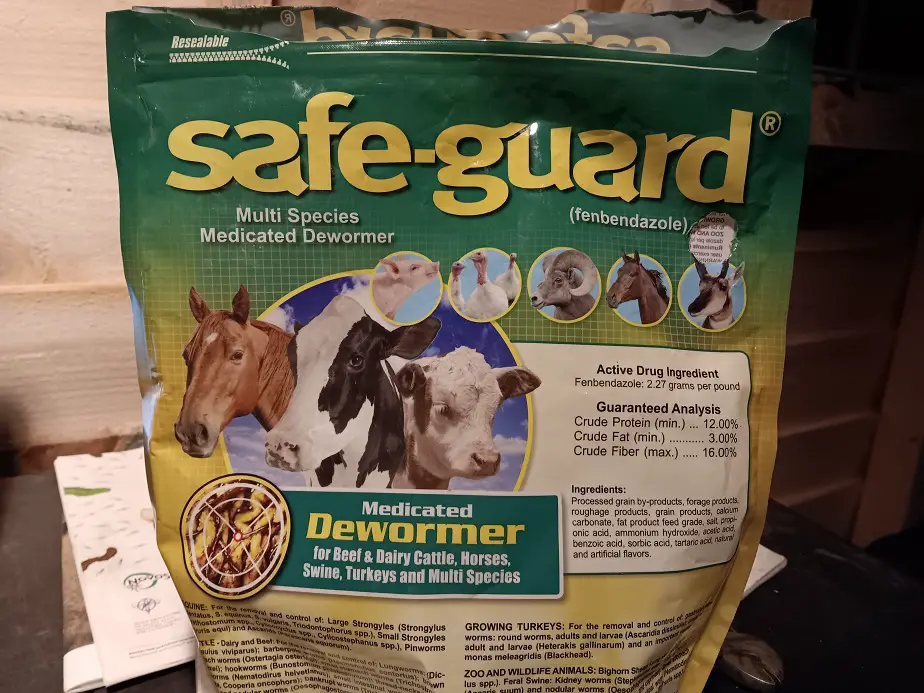
One thing you need for pigs, no matter your raising system, is a parasitic worm treatment. The best swine dewormer is Fenbendazole. It’s known by the brand name Safeguard. Safeguard is available as a medicated corn/alfalfa pellet. It’s the only way I can worm my pigs since they won’t stand still for an injection of Ivermectin. It’s easy and cheap.
- There is a stronger pellet for swine only. Here it is on Amazon
- There is a weaker pellet for general barnyard livestock, including swine. Here it is on Amazon.
I use the multi-species version because it’s what’s available in my local store and I can use it for my chickens too. It’s the most effective swine wormer and the easiest to administer. I use it on all weaned piglets and adults twice a year. Don’t go without it.
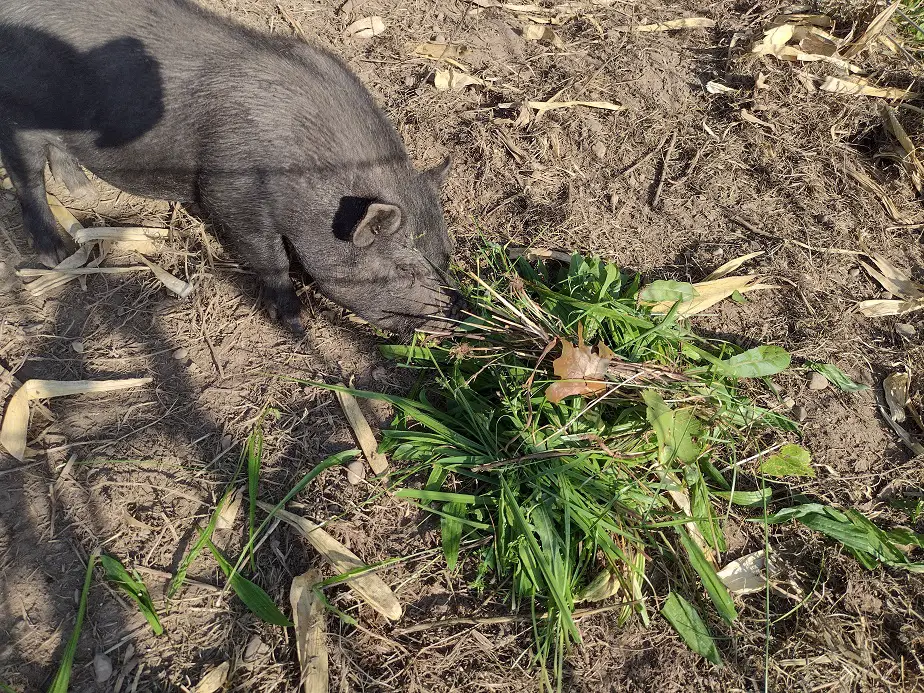
Feeding Pigs for the Best Health
For the healthiest pigs, include some fresh, wild pasture fodder in their feed daily. Fresh plants like grass and chickory are incredibly high in vitamins and minerals, and have a host of health benefits for pigs. Consider it like eating a small salad a day. Clean outdoor raising conditions also improve pigs’ health.
Sometimes, fresh fodder isn’t available. We can’t get grass in the winter because of the snow. In that case, I like to offer a small amount of quality hay to the pigs. It’s not as good as fresh, but it till improves their health, make them seem happier, and it tends to increase their growth a little.
One old pig farmer told me that his secret to raising better pigs in the winter is to give them some hay. Winter is hard on pigs and we expect to see some reduced growth in the cold months, but feeding a little hay, it seems, can help that.
For the most part, feeder pigs won’t have too many health issues in the 6 month span from birth to butcher. Older pigs have more concerns. One of them is weight of the animal. Some pigs are prone to getting fat, which is hard on their body and reduces breeding effectiveness.
A lot of the smaller breeds are prone to this, mainly because they don’t quite have the same feed needs. These breeds are commonly known as lard breeds because if you feed them enough, they will get very full of lard. Commercial breeds have had that fat-producing gene bred out and are more lean.
Usually, lard breeds are fed at 1/3 to 1/4 less daily ration than commercial types. That’s a feed-to-weight ratio of 1:3 instead of 1:4. Because of the difference in genetics and variance in feeds, sometimes that needs to be dialed down a bit lower. Lard breed feeders are usually fed 1 lb. per 3 lbs. body weight.
I personally raise smaller lard breeds like the Kunekune, Guinea Hog, and Potbelly. We don’t free feed. I adjust intake based on their visible condition. We generally butcher at 6 months with around 1/2 inch of backfat, which is the goal. You can get one fat if you want, but they will be pretty stressed from it.
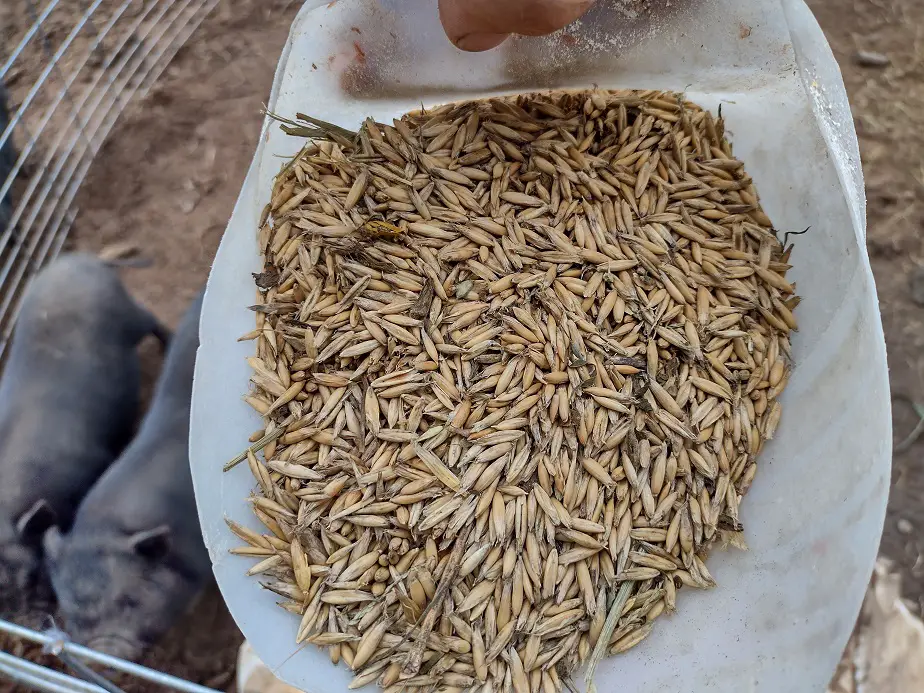
Feeding Pigs for the Lowest Cost
Formulating your own feed, utilizing food waste, and identifying cheap locally available options are great ways to feed pigs cheaply. Fermenting feed and feed ingredients improves their nutrition and digestability, making your feed go further. Pig pastures are a great way to cut feed costs too.
The best way I have personally found to save the most money on feed is to buy corn and oats from my neighbor and ferment them for the pigs. Besides the gut-health benefits gained, fermenting grains greatly increases the protein content of grain, particularly lysine which is essential to pigs’ growth.
I ferment the grains well, which increases the overall protein by 40 percent or more, and more than doubles the lysine. I have found that to be a complete energy and protein ratio. All they need is vitamins and minerals added. We get those from pasture in summer and hay in winter.
Here’s a study on fermenting corn
We don’t add any other protein source. I trialed adding roasted soybean and soybean meal at 10 percent of the total feed and didn’t see any additional gains. Here are our results on fermenting whole, un-ground grains.
- Fermented yellow corn-14 percent protein
- Fermented oats-17 percent protein
- fermented corn/oat mix– 15.5 percent protein
The percentages can vary a little depending on the quality of the grain and how well it was fermented.
Here’s a link to an article on fermenting grains for pigs
You can ferment even a regular pig ration and see improvements. Although fermenting adds some vitamins (mainly vitamin A) to raw ingredients, some of the synthetic vitamins added to feed can be lost in the fermenting process, so bear that in mind.
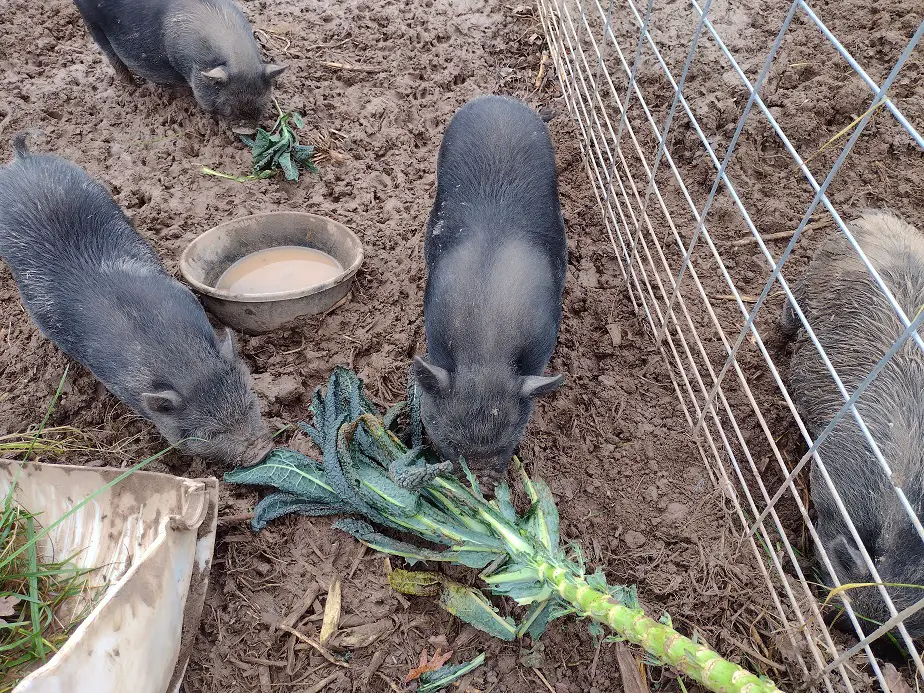
Alternative Options for Feeding Pigs
Pasture, starchy root vegetables, food waste, and hay can be alternative feed ingredients for pigs. Potatoes, sugar beets, kitchen scraps, and bakery waste are good examples. Other options are tree leaves, silage, jerusalem artichoke, and unsellable produce.
We try and grow what we can for our pigs. Jerusalem artichoke, potato, pumpkin, and potato are what we’ve done so far. This year I’m growing sugar beet. They like it and it grows well in the area. When we get into a lot of the alternative, vegetation-type feeds, it’s much more useful to a heritage breed pig.
Landrace and more wild breeds also do fairly well i these feed types. They have a slightly different digestion and different genetics in growth and metabolism that allow them to do well on a more fibrous, vegetative feed option. I know a guy who finishes Mangalista pigs on fields of turnip and daikon radish.
In days gone by, they were selectively bred to do well on that sort of diet and unlike modern production pigs, it’s not been bred out. That’s why I like the heritage breeds so much. They’re more conducive to a non-typical farming operation.
Now, fermenting these type of feed options makes it more appropriate for commercial-type pigs. Although, the heritage breeds still tend to do better. There has been several studies on replacing commercial pig feed with mulberry leaf and it has shown some incredible results.
Here’s a study on feeding pigs fermented mulberry leaf
Just bear in mind that there are a lot of options when it comes to feeding pigs well and what works for one farmer may not be practical for another. And if you have any questions, ask in the comment section below.
Related Articles:

